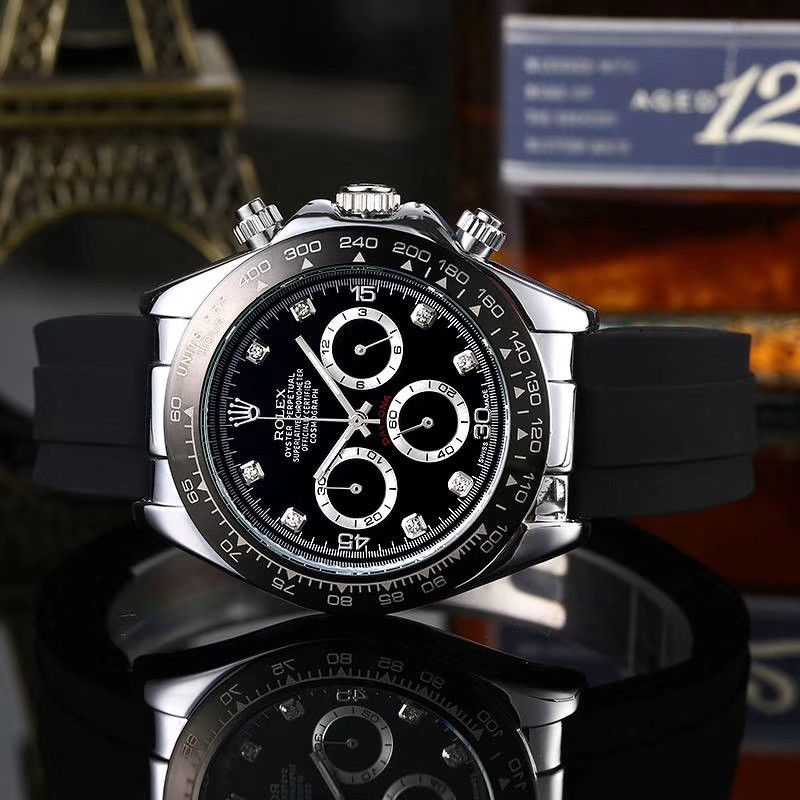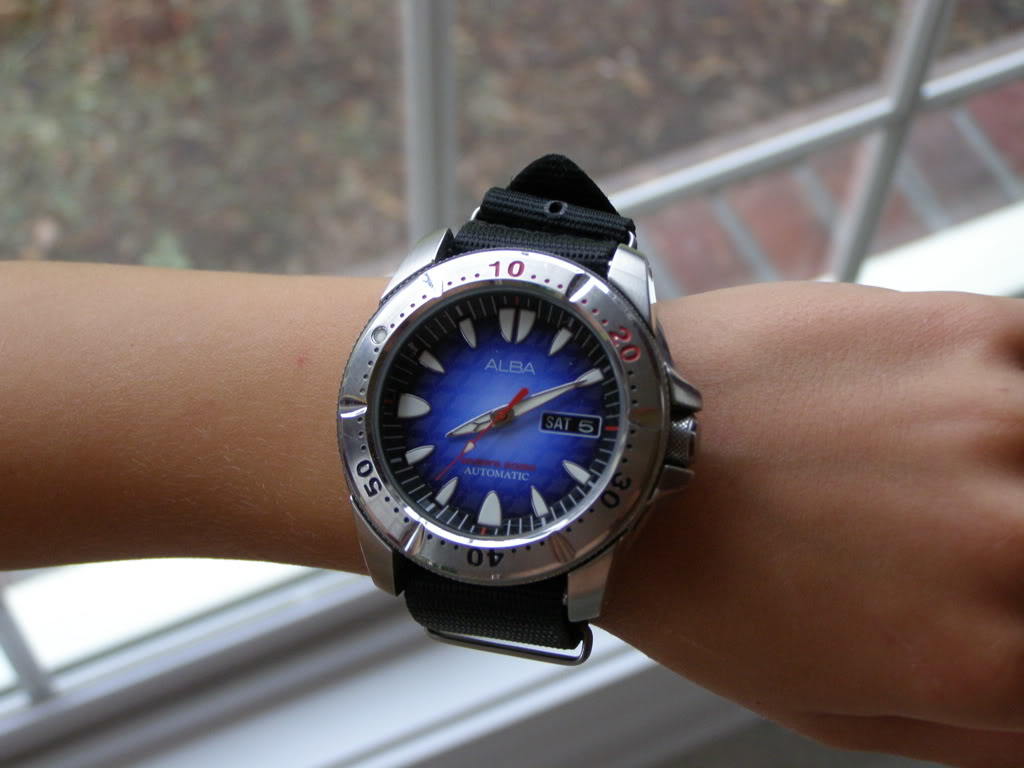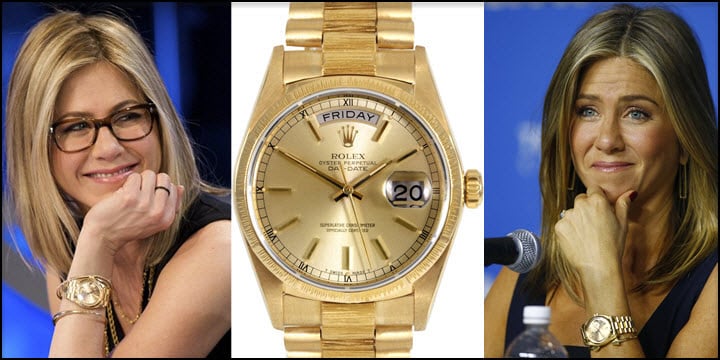For decades, contemporary consumer trends were calling for larger timepieces, and across the entire industry, luxury watches were getting bigger. However, although the average watch case size was getting increasingly larger from one year to the next, the average size of the human wrist was not. Rolex is one of the world's most coveted luxury brands. With an ever-expanding pre-owned market, there has never been a better time to finally add your grail Rolex to your collection.
If it's a classic dress watch that you desire, the Date in 34mm and classic 36mm Datejust are some of the best Rolex watches for smaller wrists. The Oyster Perpetual is another popular gents watch available in a broad range of case sizes, including 28mm, 31mm, 34mm, 36mm, 39mm, and just recently, 41mm. And if you really want the flagship offering from Rolex, the classic Day-Date 36 also makes for a perfect fit on slender wrists who want a solid gold statement watch.
On the other hand, choosing the kind of strap or band and the material used should be based on your preferences. Metal bracelets may come in a mesh or a link form and are mostly preferred by men with larger wrists. At the same time, metal bands are still popular for women's watches although most prefer the leather straps.
Fabric or nylon straps are commonly used for sports watches though these kinds of straps can also be seen on casual watches. Size seems to take a significant meaning in all segments of men's life. From his body to his cars, size can impact a man's life in all kinds of ways. Big things have always represented masculinity and strength in the men's world. Hence, having a big watch can represent a lot more than just a time teller. Consequently, it is no wonder that wristwatches for men mostly grew in size during the course of history and rarely swung back to smaller cases.
But, on the other side, there are giants like Diesel Grand Daddy Chronograph (Ref. DZ7262) of 76mm or Musk MR2919 of astonishing 90mm in diameter. As there are many great large watches, these two included, we don't doubt their worth, but, if you don't own one, imagine wearing it for 6-8 hours straight. Not an easy task, which confirms the theory that it's not easy to be a man in this competitive world.
But luckily, the times are changing and values evolve. Size is a funny thing, and once someone buys a larger car, larger home, or bigger television it is difficult to return to a smaller size. When I first started getting into mechanical watches I was buying timepieces sized from between 36-40mm wide.
Once I began to wear larger timepieces smaller ones seemed petite by comparison, and the same is true for many people who go from more traditional watch sizes to modern ones. What matters most whenever shopping for a luxury watch is how it makes you feel when it's on your wrist. If you're in the market for a sport or tool watch from Rolex, the Yacht-Master 37 also offers a modest size and weight perfect for many slender wrists.
The lugs are nicely tapered, and the midsize edition is available on either an Oysterflex or Oyster bracelet. It exudes the classic tool watch aesthetic that many collectors seek without the larger diameter that is characteristic of most other sports models. The Rolex Explorer at 36mm or 39mm is another great option with more modest styling that offers a smooth bezel and a simple, time-only dial. Whether you have slender wrists or simply want a high-end timepiece with a slightly more compact overall profile, the current luxury watch industry has a number of fantastic options. Simply put, there is a perfect timepiece for every possible wrist size, so below we take a look at some of the best luxury watches for those with slender wrists. Today watches in the 40 to 42mm range are considered "standard," and if you're looking at a chronograph or dive watch there's a good chance it's a few millimeters bigger still.
The consensus amongst some prominent watch folk is that this case inflation is a holdover from an era of conspicuous consumption. Let us start with Seiko's Spirit collection that seemed under the radar for some time, but plays the perfect role for Seiko mods due to their colors. Another nice example is his angelic brother, Seiko SARB035 White, that you can also fit with any Seiko 20mm watch bands. The same goes for all watches we picked this time, whether their cases are 37mm, 38mm, 39mm or 40mm, they all have lugs of 20mm, meaning the tan line won't be too wide. Watch lovers literally argue about the "proper" watch size. The bottom line is that members of each faction are literally insulting one another on a regular basis in an on-going debate.
Diameter, case thickness, straps, and lug width are the main elements that factor into properly sizing a watch. Case diameter is the length of the watch face head-on. This includes the bezel (the ring surrounding the watch's face). Some bezels are quite thin, while others — Submariners or Omega's Planet Ocean series, for example — are noticeably thicker.
When it comes to diameters, most men's watches range from 36mm to 43mm. History, however, has tended to favor smaller profiles; the look is refined, though small when held up against today's designs. The brand's catalog includes everything from casual and formal dress watches to pilot's watches and a vast assortment of different divers. Additionally, Oris typically offers multiple sizes of many of its top models, which means that buyers with slim wrists have all the same options available. The best Tudor watches for small wrists include the Black Bay, which features 32mm, 36mm, and 41mm case options.
A smooth bezel surrounds the case, and the dial is simple and easy to read. Additionally, the Black Bay is sold on either a metal bracelet, a fabric, or a leather band. The versatility of the Black Bay makes it a very desirable option for wrists of all sizes. Other factors to consider are the size of the crown, pushers, and hour markers. These features can significantly impact how the watch appears on the wrist, even if the watch's size is one that you are normally comfortable wearing.
Is 40Mm Apple Watch Too Small For A Man The type of bracelet can also affect the way a watch wears. For example, metal bracelets typically wear larger than leather straps, and the amount of taper in a bracelet or strap can also alter the perceived size of a watch on your wrist. Case diameter is certainly the first thing you will want to look at, but these other factors are all important to consider when buying a new watch. Dimensions, calibers, casebacks, complications, color, straps — each year watchmakers unveil more dizzying choices to suit every taste and trend in the world of timepieces.
While classic watch designs remain so because of their innate elegance and appeal, there's often a wide variety of subtle differences. Whereby those in the know can tell when a certain watch was made and even how much you paid for it. But, rather than trying to impress someone else, you should always base your watch selection on what you find personally appealing.
In addition, size, that includes both the diameter of the watch's case and its thickness, and fit are crucial components to consider when searching for the perfect timepiece. My advice, first and foremost, is to buy whatever the hell you like regardless of size. My second bit of advice is to consider embracing the smallness. In fact, if recent industry trends are any indicator, more small watches are on the way. The vintage watch market is booming right now, and watch collectors have come to love the authentically small case sizes of yore. Watchmakers today have seemingly taken notice, offering dress and sports watches that are closer in size to their forebears.
Some people look good on a larger watch because they have a big wrist and that watch won't work for a small wrist group. If you have a 7 inch wrist, you should go with a 36mm-42mm diameter watch. But, if your wrist circumference is more than 7.5 inches, then a 40mm or more timepiece would be perfect. The lug distance is measured from the lugs at the top of the watch case to the lugs at the bottom.
Though that may seem identical to the watch case size, the lug distance can vary for watches with the exact same case size. If possible, you want the lug distance to fit on the flat surface area of your wrist and not have overhang. Generally, choose a smaller lug distance for smaller wrists. For all wrist sizes, you typically want a lug distance that is 75 to 95% the size of the flat part of your wrist for the best fit. Once upon a time, luxury watchmakers routinely made midsize versions of their dive watches, often in 36mm.
For instance, Omega made a 36mm Seamaster 300m Diver for decades, and it was excellent. But that trend has since gone the way of the dodo, with basically only Oris keeping the flame alive. The most traditional men's watch sizes fall into this category.
These days, men's watches that are this small tend to mostly be dress watches, but field watches are also fairly common in the space. One of the best Oris watches for smaller wrists is probably the Diver's 65. Breitling is notorious for its often large and polarizing watches. But that doesn't mean that they don't also cater to gentlemen with a smaller wrist size. One such example is the Navitimer 1 Automatic in 38mm, which was released just recently in 2018.
At 10mm in thickness, the watch hugs the wrist nicely. Also buzzing among Breitling enthusiasts with slender wrists is the Breitling Colt, which is available in a handful of sizes, including 38mm and 41mm models. A 40 mm dress watch that is all dial will wear much, much larger than a 40 mm diver that features a 5 mm wide bezel around its smaller dial. When the surface of a watch is broken up into different elements, it shrinks visually. This is not typically reflected in a watch size chart.
Junghans is the king of Bauhaus design thanks to the German brand's association with master of the style, Max Bill. The original Max Bill watch debuted 60 years ago, and it remains the template for minimalist dress watches today. While sub-40mm watches are nowhere near as common as they used to be, there are still plenty of great ones out there for the small-wristed and classically-inclined among us. The best small watches for men offer up all of the style and capabilities that you'll find in large modern watches, but they do so in a more conservative and comfortable package. Most of the big brands still offer at least some men's watches in smaller sizes, and a slew of newer microbrands are also helping to bring back the 30-something-millimeter watch for guys.
So take a stand against the scourge of oversized watches and check out our list of the best small watches for men below. The funny thing is that sometimes when I go back to wearing a smaller watch, I recall what I am missing. The bottom line is that once most people begin to wear a larger watch, in the 42-44mm wide range and above, it becomes very difficult for them to go back to wearing a smaller watch again. Even though many of the aBlogtoWatch writers are fans of large timepieces the purpose of this article isn't to defend them or convince you to wear one. Our goal is to explain the reasons why timepieces for both men and women have become larger, and help consumers feel comfortable with the watch sizes that they prefer. The Tank holds the title of the best-known Cartier watch for men with smaller wrists.
Its design is sleek, timeless, and typically includes a rectangular case topped with the brand's iconic tall Roman numeral markers. The collection is varied, with several bracelet options, case materials, and dial color options. Let's assume the wearer has a slender wrist and would like a watch that hugs the wrist nicely with lugs that don't protrude over the sides. If their wrist measures around 6″, a 31mm, 34mm, or 36mm timepiece will suit them nicely. If the lug-to-lug measurement isn't too long, a watch in the 40mm category might also be appropriate, especially if it is a sports model. If the wrist measures between 6.5″ and 7″ , a case size between 36mm and 40mm should be comfortable.
Again, depending on the measurement between the lugs, something larger than 40mm might also be suitable. These measurements are completely subjective and are meant as a general guide because as we've already mentioned above, watch tastes can vary from one individual to the next. From there, the size is also characterized by the case thickness and also from lug to lug across the length of the case. If the watch has a slim profile or more tapered lugs, it might be easier to forgive a larger diameter because it will hug the wrist more tightly. Additionally, the type of watch can also influence its perceived size on the wrist. For example, both the Datejust 41 and the Submariner have case diameters of 41mm, but the Datejust will likely wear slightly larger since its dial makes up a greater proportion of its overall size.
Fastening a watch to your wrist today seems so uncomplicated, it's innate. And over the last 100 years, straps have quickly evolved to include diverse metal and material types — becoming as symbolic as the watches themselves. Rolex's Oyster bracelets and clasps are perhaps the most iconic, though there are many others.
Rubber, nylon, leather, metal — for every differentiating element that distinguishes one finely designed timepiece from the next, there are just as many strap materials used to complement them. Determining which strap works best with a watch is, again, largely subjective to the wearer and also defined by its "intended" use. Some measurement and understanding of strap type, however, is essential to getting it right. With some models, 40 to 42 mm could still work, depending on the bezel size or the hour marker circle size . Even just a couple decades ago, if you bought a men's wristwatch, it was probably small.
Like, just-a-smidge-bigger-than-a-Kennedy-half-dollar small. For nearly as long as men have been wearing watches on their wrists, watches ranged from about 33 to 36 millimeters, and those that were any larger were stylistic outliers and chunky sports watches. In fact, some large watch designs from way back were derided for being unnecessarily big. Accessible to a wide range of wrists, watches in the 36+ to 38mm case size are traditionally known as "mid-size" watches.
They're wearable and comfortable for many wrists and frequently are available in sports watch styles like dive watches and chronographs. Much of TAG Heuer's catalog skews modern, with a plethora of oversized cases and even a few smartwatches. But the Carrera line gets some vintage love that takes us back to the pre-1980s days of TAG-less Heuer, when the brand was known for crafting quality motorsports chronographs. This version of the Carrera blends both sides of the brand, with a vintage design getting a very-of-the-moment makeover thanks to a trendy teal-green dial. Large watches are a big issue because they make it difficult for people to wear "traditionally sized" watches.
Often times "larger watches" are also called "modernly size" or "contemporary." Vintage watches are often smaller and thus often don't conform to modern size taste. In any event, this watch size issue is a huge source of debate among watch wearers. Just like the bracelet, the case size is entirely up to the wearer.
Those with a smaller wrist will find most watches under 40mm suitable. However, watch tastes are different among collectors. Some love how a larger watch looks on the wrist, in which case 40mm or larger might suit them best.


























No comments:
Post a Comment
Note: Only a member of this blog may post a comment.